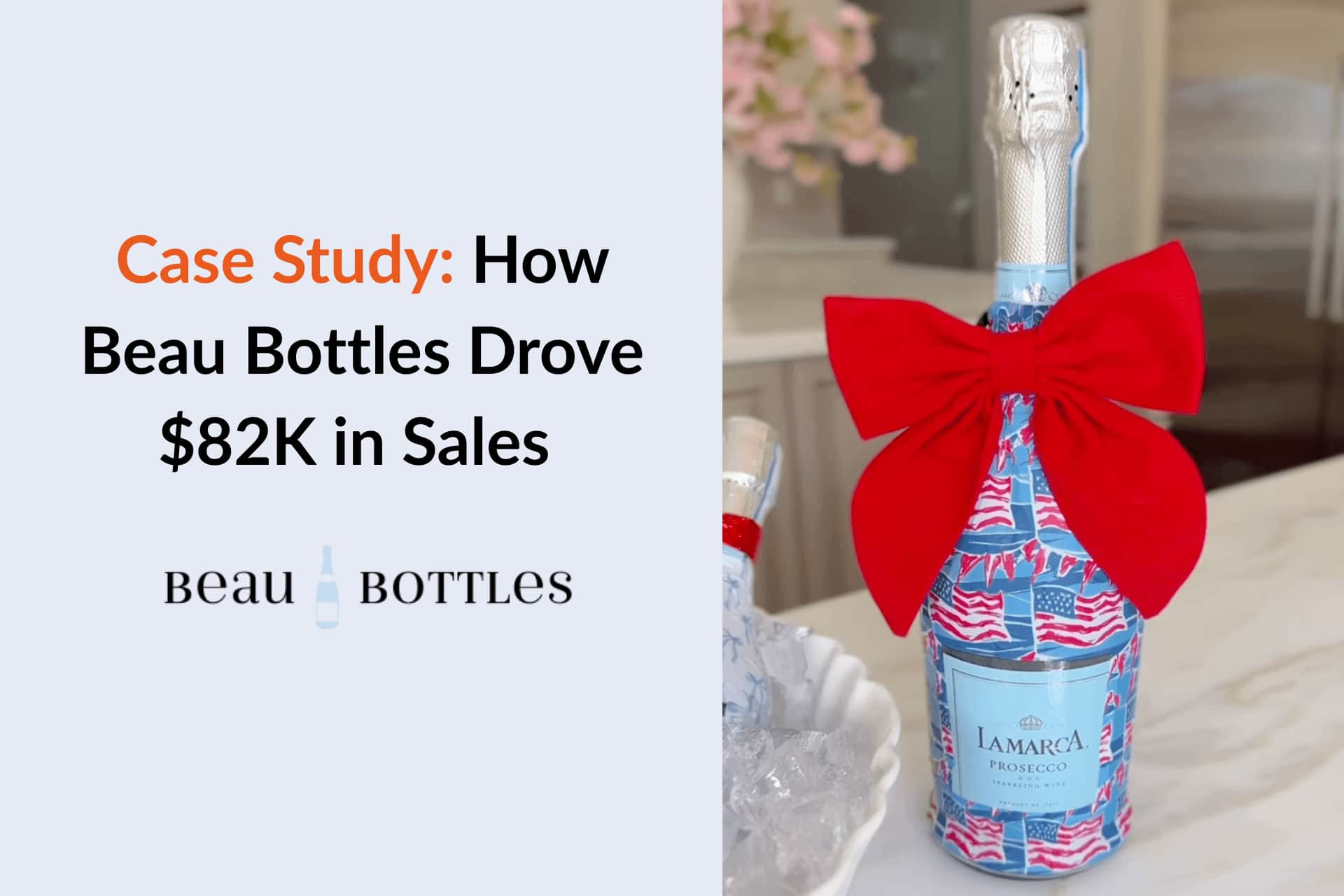





Cloutflow has positioned itself as a rising player in the influencer marketing space, but many users highlight key drawbacks that push them to explore alternatives.
On platforms like Reddit, G2, and other forums, marketers often mention its limited campaign tracking and weak reporting features, lack of advanced integrations with eCommerce platforms, and unclear pricing structure that makes scaling difficult. These pain points have left many brands searching for tools that offer more transparency, automation, and measurable ROI in their influencer campaigns.
In this article, we’ll explore the Top 10 Cloutflow Alternatives:
Before exploring the best Cloutflow alternatives, it’s important to understand why many marketers and agencies are looking for other options. Based on user feedback from platforms like Reddit and G2, here are the most common pain points:
Users have reported that Cloutflow’s database is not as extensive compared to competitors, especially when it comes to niche influencers or emerging creators on TikTok and YouTube. This makes it harder for brands to run highly targeted campaigns.
While Cloutflow offers basic performance metrics, several reviewers mentioned that the platform lacks deep audience insights, fraud detection tools, and campaign ROI tracking. This forces users to rely on external analytics tools, adding unnecessary complexity.
On G2, users noted that Cloutflow’s pricing feels steep compared to the value delivered. Many alternatives offer more robust features such as affiliate tracking, automated reporting, and CRM integrations at similar or even lower price points.
Another recurring complaint is that Cloutflow’s workflow tools are not as intuitive or scalable for larger campaigns. Agencies in particular highlighted the lack of bulk outreach, automated reminders, and customizable reporting, making campaign execution time-consuming.
Our comparison focuses on several key aspects:
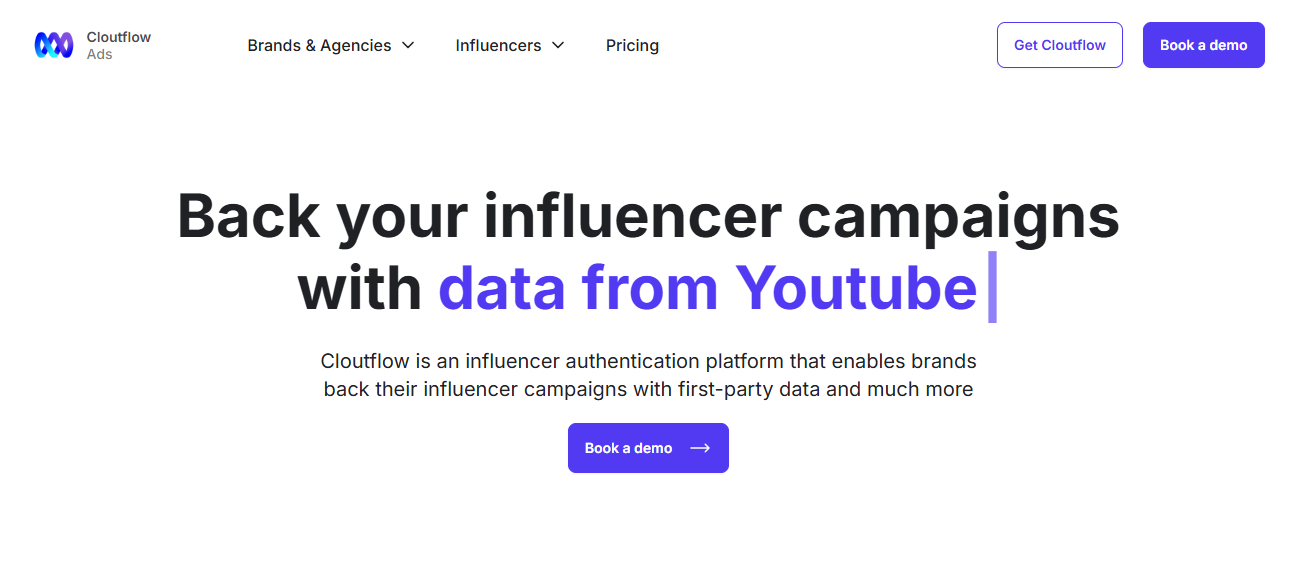
Best For: Cloutflow is best for brands that value data authenticity and transparency, especially those in India and APAC looking to collaborate with influencers using first-party verified data.
Platform Coverage:
Pricing: Based on our research, Cloutflow offers different plans and options:
Reviews: 4.2 / 5.0 (Glassdoor)
Ease of Use (UX/UI): Brands report that campaign setup and reporting dashboards are straightforward and data-focused. However, some creators mention the authentication requirement adds friction, even though it increases trust.
Customer Support: Customer support is considered helpful for campaign setup and execution, but user feedback is mixed. Some appreciate responsiveness, while others highlight issues with delayed payouts to creators.

Best For: Influencer Hero is best for D2C and eCommerce brands that want to scale influencer marketing campaigns across multiple platforms with advanced automation, deep analytics, and strong ROI tracking. It’s particularly valuable for teams managing large-scale gifting, affiliate, and content campaigns.
Platform Coverage:
Pricing: Influencer Hero offers flexible pricing plans to accommodate growing brands. All plans include core features and can scale as the influencer program grows.
Reviews: 5.0 / 5.0 (Capterra)
Ease of Use (UX/UI): Influencer Hero is known for its intuitive, streamlined design. The clean dashboard, drag-and-drop workflows, and logical campaign structures make it simple for both small teams and enterprise-level marketers. Automated workflows and customizable templates further reduce manual tasks, helping brands save hours weekly.
Customer Support: Customer support is one of Influencer Hero’s strongest features. Every plan includes a dedicated account manager from day one, with optional strategy consultations to guide growth. Support options include 24/7 live chat with real humans, responsive email assistance, and an extensive Help Center with tutorials. Pro plan users even get access to a private Slack channel for continuous, real-time support.
While Cloutflow focuses heavily on influencer authentication and first-party data verification, it lacks the broader automation and eCommerce integrations offered by Influencer Hero. Cloutflow is a good fit for brands mainly concerned about influencer fraud, but its pricing jumps steeply at higher tiers and advanced integrations (like Shopify) are still “coming soon.”
Influencer Hero, on the other hand, provides a complete end-to-end solution—from discovery to outreach, gifting, CRM, affiliate management, and ROI tracking. Pricing starts at $649/month, making it more accessible than Cloutflow’s Plus plan at nearly $999/month . With its intuitive UX, AI-powered automations, and premium 24/7 support, Influencer Hero is a stronger choice for brands that want to scale efficiently without juggling multiple tools.
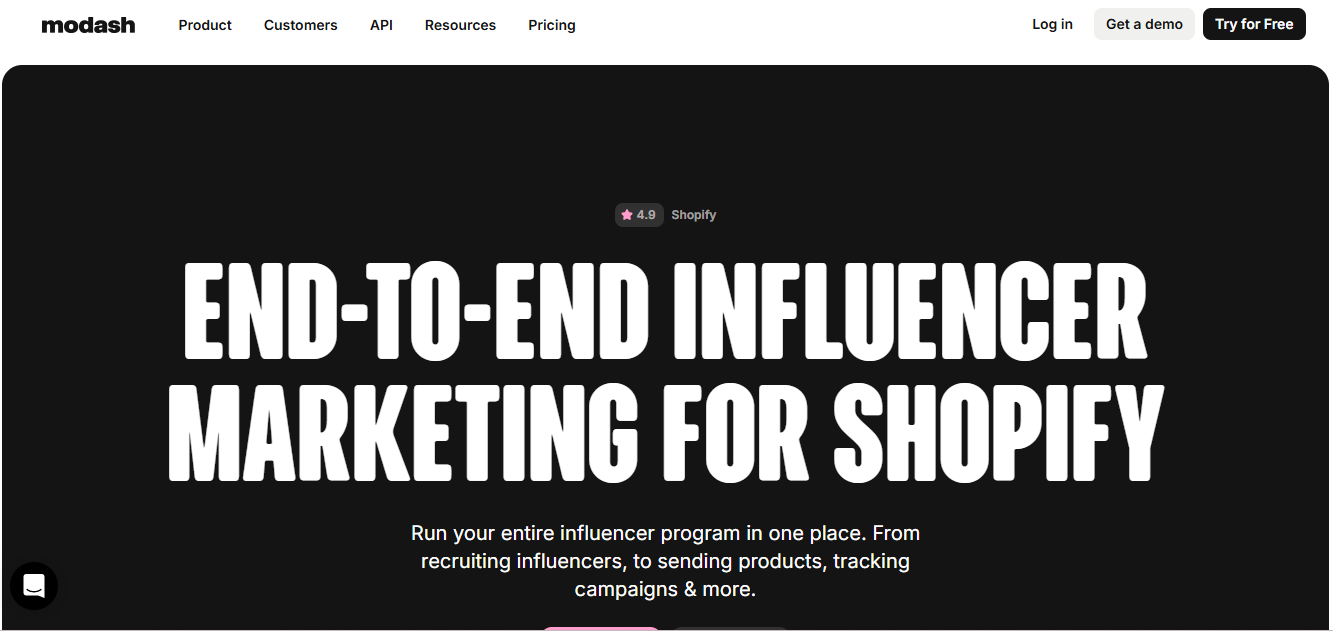
Best For: Modash is best for eCommerce brands on Shopify or global companies that need access to a massive creator pool and want to run affiliate, gifting, and paid campaigns with streamlined workflows. Its strength lies in scaling influencer discovery and outreach across Instagram, TikTok, and YouTube.
Platform Coverage:
Pricing: There are different plans and options.
Reviews: 4.7/5 (G2)
Ease of Use (UX/UI): Users highlight Modash’s clean and intuitive interface, making it easy to filter creators by niche, hashtags, location, and engagement. The built-in CRM and dashboard centralize campaign management, which many say reduces time spent juggling multiple tools.
Customer Support: According to user feedback, Modash provides excellent onboarding and support. Brands report fast responses from the team and clear guidance when setting up campaigns. The support is praised for being both responsive and knowledgeable.
Cloutflow emphasizes authentic, first-party verified data by requiring influencers to authenticate their profiles, making it a strong fit for brands concerned about fake followers or fraudulent metrics. Modash, on the other hand, gives brands access to a massive creator database (350M+ profiles) without requiring opt-ins, making it more flexible for global discovery.
In terms of pricing, Cloutflow starts with a free plan and scales up to enterprise packages ($20K/year), or a 10% per campaign fee, which can become costly for high-volume brands. Modash offers more predictable, tiered pricing starting at $199/month, with the Performance plan at $499/month — making it more affordable for ongoing large-scale campaigns.
If your priority is data authenticity and compliance, Cloutflow may be the better choice. But if you’re looking for scale, automation, and advanced discovery tools at a more predictable cost, Modash comes out on top.

Best For: Upfluence is best for eCommerce brands on Shopify and Amazon that want a full end-to-end solution for influencer discovery, outreach, and affiliate campaign management. It’s also a strong fit for mid-to-enterprise businesses looking for data-rich influencer insights and automated campaign tracking across multiple social platforms.
Platform Coverage:
Pricing:
Reviews: 4.5/5 (G2)
Ease of Use (UX/UI): Users often highlight that Upfluence offers a robust yet complex platform with many advanced tools available in one place. While the dashboard is highly detailed and powerful, some reviewers mention that the learning curve can be steep for beginners who are new to influencer marketing software. Overall, experienced marketers tend to find it efficient once the setup phase is complete.
Customer Support: Upfluence provides dedicated support channels, including account managers and onboarding sessions, which users find helpful for navigating the platform’s complexity. Some feedback suggests that while the team is responsive, the reliance on annual contracts means support is most useful for committed long-term users, rather than those testing short-term campaigns.
Cloutflow offers flexible options, including a free plan and pay-as-you-grow pricing, making it attractive for small businesses or brands testing influencer marketing. In contrast, Upfluence starts at $1,276/month with annual commitments, which can be prohibitive for startups but more appealing for established brands seeking an enterprise-level all-in-one platform..
Another difference is in focus areas. Cloutflow emphasizes first-party verified data and transparency to reduce influencer fraud, making it a safer choice for brands prioritizing data authenticity. Meanwhile, Upfluence shines in its eCommerce integrations with Shopify and Amazon, allowing direct sales attribution and ROI tracking that Cloutflow currently lacks.
Ultimately, businesses seeking flexible entry-level pricing and fraud prevention might lean toward Cloutflow, while larger enterprises or eCommerce-heavy brands looking for end-to-end campaign management and integrations will find Upfluence a stronger fit.

Best For: Captiv8 is best for large enterprises and global brands that want advanced influencer discovery, competitive tracking, and deep campaign analytics, but who also have the budget for premium, enterprise-level pricing.
Platform Coverage:
Pricing: There are different pricing options:
Reviews: 4.1/5 (G2)
Ease of Use (UX/UI): Users highlight that Captiv8’s interface is feature-rich but complex, which can make the learning curve steeper compared to lighter tools. However, once teams get used to it, the filter locking, drag-and-drop reports, and collaboration tools make workflow management smoother.
Customer Support: Customer support is often a pain point. Reviews from Reddit and G2 mention slow responses, unresolved payout issues, and unresponsive service teams. While the platform provides enterprise-level onboarding, ongoing support has been flagged as inconsistent.
When comparing Cloutflow and Captiv8, the biggest difference lies in pricing and market focus. Cloutflow is designed for small to mid-sized brands with flexible pricing starting at $199/month and even a free plan, while Captiv8 is enterprise-first, demanding a $25K annual commitment plus heavy monthly add-ons.
Another key distinction is data focus: Cloutflow emphasizes first-party authenticated influencer data, ensuring brands reduce fraud risks. Captiv8, on the other hand, provides deeper competitive intelligence and analytics, including ROAS, sentiment, and EMV tracking.
Finally, while Cloutflow offers simpler campaign tracking and talent management features at an affordable price, Captiv8 is better suited for enterprise teams who need advanced collaboration, competitive benchmarking, and affiliate storefront solutions. If you’re a growing brand looking for affordability and transparent data, Cloutflow is a stronger fit; if you’re an enterprise with bigger budgets and complex needs, Captiv8 delivers the advanced analytics and scale.

Best For: CreatorIQ is best for large enterprises and global brands that need an end-to-end influencer marketing solution with advanced compliance, reporting, and campaign management. It’s particularly suited for companies running multi-region campaigns at scale.
Platform Coverage:
Pricing: There are different plans:
Reviews: 4.7/5 (G2)
Ease of Use (UX/UI): Users describe CreatorIQ as a powerful but complex platform. Its depth of features makes it robust, but some note the learning curve can be steep, especially for smaller teams. However, once onboarded, brands appreciate the streamlined workflows, strong reporting dashboards, and easy-to-share live links.
Customer Support: CreatorIQ is often praised for its dedicated support structure, including onboarding managers, customer success teams, and quarterly planning support. Users highlight the strategic guidance that goes beyond simple troubleshooting. Some mention that while the support is strong, it aligns more with enterprise-level expectations than smaller, hands-off setups.
Cloutflow focuses on data authenticity through influencer authentication, making it appealing for smaller brands and those concerned about fake followers. Its pricing is more flexible, with free and growth-tier options starting at around $199/month, plus a campaign-based pricing model.
By contrast, CreatorIQ is a premium, enterprise-focused solution with pricing in the $2,000–$5,000/month range, requiring annual contracts. It offers significantly deeper integrations, advanced reporting, and compliance features, making it the better fit for global enterprises with large budgets and complex campaign needs.
In short, if you’re a smaller brand prioritizing affordability and verified data, Cloutflow may fit. But if you need enterprise-grade scalability, real-time API integrations, and end-to-end campaign management, CreatorIQ is the stronger choice.

Best For: HypeAuditor is best for brands and agencies looking for advanced influencer discovery, campaign tracking, and fraud detection across multiple platforms including Instagram, TikTok, YouTube, Twitch, X, and Snapchat. It’s particularly strong for those who want customizable pricing with analytics-driven decision-making.
Platform Coverage:
Pricing: HypeAuditor’s pricing is customizable, with the standard “Business” plan starting at around $10,000/year. Pricing can be adjusted based on the number of reports, active campaigns, and platform usage. They also offer a 24–48 hour free trial for new users.
Reviews: 4.6/5 (G2)
Ease of Use (UX/UI): Users generally find HypeAuditor’s interface intuitive once onboarded, though the depth of data and filtering can feel overwhelming at first. Once familiar, the dashboards provide powerful insights with well-structured reports and clear campaign ROI tracking.
Customer Support: Customer support is reported as helpful, especially during onboarding, which can be essential due to the platform’s complexity. Users value the personalized setup assistance but note that ongoing support can be slower at times for smaller clients compared to enterprise accounts.
The key difference between Cloutflow and HypeAuditor lies in their pricing structure and data approach. Cloutflow offers a free plan and scalable subscription or campaign-based pricing (starting as low as $199/month), making it more accessible for smaller brands or those testing influencer campaigns. On the other hand, HypeAuditor starts at ~$10,000/year with customizable tiers, positioning it as an enterprise-grade solution.
In terms of functionality, Cloutflow focuses heavily on first-party authenticated data, ensuring transparency and reducing fraud risk. HypeAuditor, meanwhile, provides a more advanced AI-driven discovery suite, fraud detection, and campaign ROI analytics, which can be powerful but comes with a steeper learning curve.
For brands prioritizing budget-friendliness and verified influencer insights, Cloutflow may be the better fit. For larger teams or agencies needing scalable discovery, detailed analytics, and advanced fraud detection across multiple platforms, HypeAuditor is a stronger—though more expensive—option.

Best For: GRIN is best for eCommerce brands, particularly those on Shopify, WooCommerce, or Magento, looking to scale influencer and affiliate campaigns with seamless integrations, end-to-end management, and ROI tracking.
Platform Coverage:
Pricing:
Reviews: 4.5 / 5.0 (G2)
Ease of Use (UX/UI): Most users describe GRIN’s interface as user-friendly and intuitive, especially for brands already operating on Shopify or other eCommerce platforms. The workflows are built to reduce manual work, though some users mention the platform can feel overwhelming at first due to the wide range of features.
Customer Support: Users generally praise GRIN’s dedicated account managers and support team for being helpful and responsive. However, smaller brands sometimes feel the support prioritizes larger enterprise clients, meaning response times and customization options can vary depending on the size of the account.
Cloutflow offers a free plan and flexible pricing models (including a pay-per-campaign option) that make it accessible to startups and growing brands. In contrast, GRIN’s pricing is much higher, starting at enterprise-level costs, which can be a barrier for smaller businesses but is justified by its deep Shopify, WooCommerce, and Magento integrations.
Another key difference is focus: Cloutflow emphasizes data authenticity with first-party verified influencer profiles, helping brands avoid fake followers and inflated metrics. On the other hand, GRIN prioritizes end-to-end campaign execution and affiliate sales tracking, making it ideal for brands who want direct ROI visibility.
If you’re a smaller or mid-sized brand looking for affordable influencer authentication and campaign management, Cloutflow is the better choice. If you’re a larger eCommerce brand with Shopify or similar integrations, GRIN’s robust CRM, affiliate tools, and ROI analytics make it worth the investment.
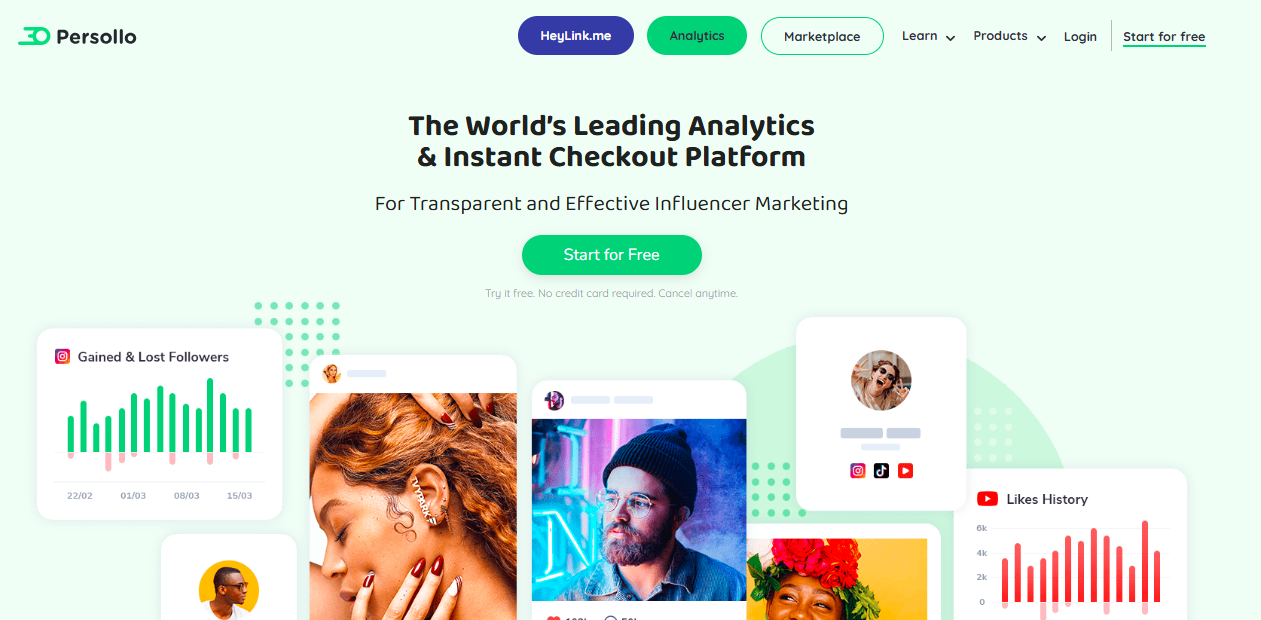
Best For: Persollo is best for eCommerce brands and influencers looking to monetize social content instantly through one-click checkout, making it ideal for impulse-driven product categories like fashion, beauty, and lifestyle.
Platform Coverage:
Pricing: Based on our research, Persollo offers different plans and options.
Reviews: No verified public reviews available on major platforms such as G2, Capterra, or Trustpilot.
Ease of Use (UX/UI): Users highlight Persollo’s simplicity and fast setup. The platform doesn’t require heavy eCommerce infrastructure—brands and creators can generate instant checkout links directly from their posts. Its focus on frictionless selling makes it especially attractive for small to mid-sized businesses.
Customer Support: Publicly available details on customer support are limited. However, enterprise and custom plan users gain dedicated support and tailored services, including onboarding and API access. This tiered approach suggests smaller users may have less visibility into direct support options compared to higher-end customers.
Cloutflow focuses on influencer authentication and first-party verified data, making it a strong choice for brands that prioritize transparency, fraud prevention, and structured campaign management. In contrast, Persollo is built as a social commerce engine, offering instant one-click checkout directly from influencer posts to maximize conversions.
When it comes to pricing, Cloutflow offers a free plan for up to 10 profiles, with paid plans scaling up steeply to enterprise levels (~$20,000/year). Persollo, meanwhile, entices users with a forever-free starter plan, but monetizes through transaction fees (3.9% + $0.30 per sale) and tiered paid reports, making it more appealing for budget-conscious brands that want to test social commerce without heavy upfront costs.
Ultimately, choose Cloutflow if your priority is authentic influencer data and transparent campaign workflows, and Persollo if you want seamless conversions and instant monetization of influencer content.
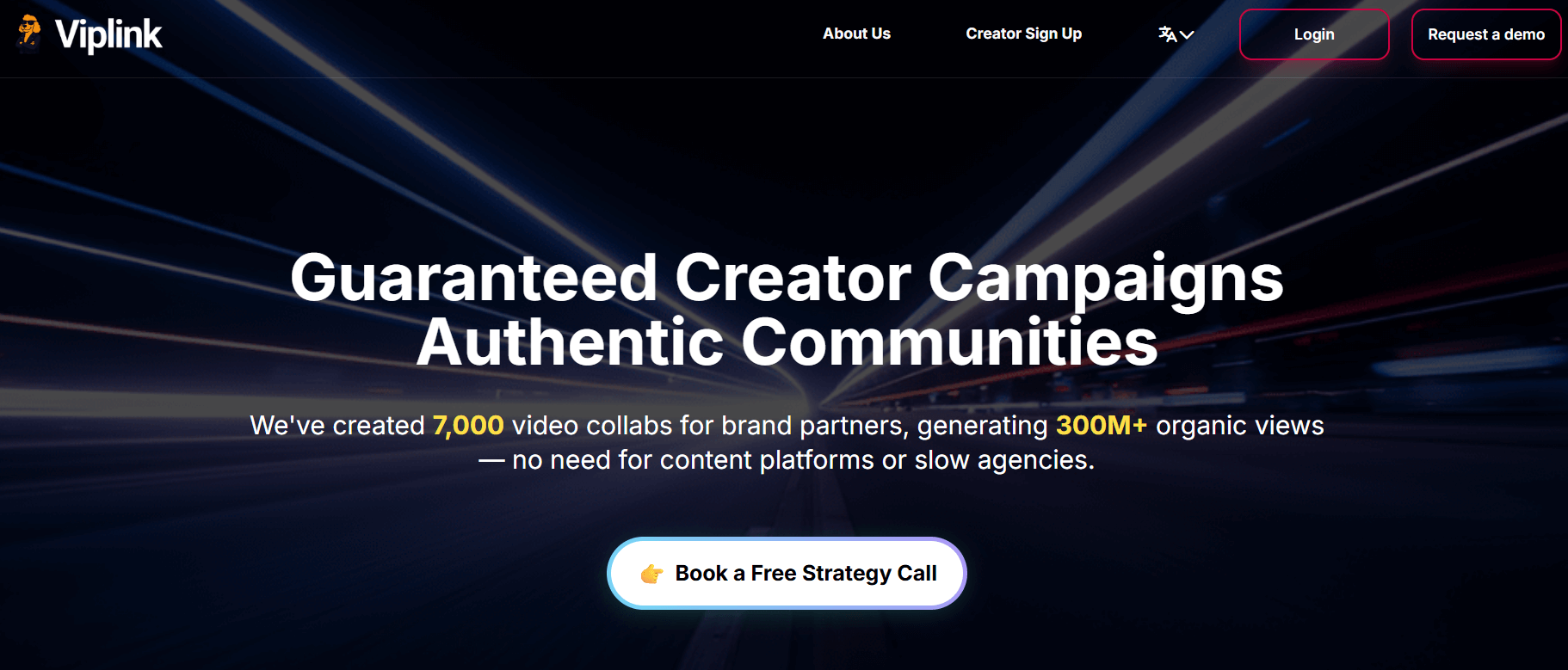
Best For: Consumer brands, DTC companies, and marketing teams that want to engage audiences through authentic creators and user-generated content (UGC) without upfront costs.
Platform Coverage:
Pricing: No upfront fees; payment is only required once you approve creators and content. However, brands have to pay an additional fee—amount not publicly disclosed—based on what is paid to each creator.
Reviews: 4.4/5.0 (G2)
Ease of Use (UX/UI): Users highlight one-click content approval flows and streamlined dashboards that simplify creator management and minimize back-and-forth communication. While the platform is intuitive, some users mention limited collaboration features and constrained geographic coverage.
Customer Support: Viplink AI manages briefings, timelines, and community activations from start to finish, making it a hands-off solution for brands. Users value the clarity of communication but note that greater transparency on software updates would be helpful.
Cloutflow offers subscription-based pricing with features like automated outreach, influencer CRM, and campaign tracking included upfront, making it predictable for budgeting. In contrast, Viplink AI has a zero-risk model with no upfront fees—brands only pay after approving creators and content—but it also includes undisclosed additional fees tied to creator payments, which may make cost forecasting harder.
Another key difference is in platform scope and usability. Cloutflow is better suited for teams that want self-service control, influencer discovery, CRM, and analytics in one dashboard. Viplink AI, on the other hand, is a full-service option where much of the management (briefings, creator payments, and activations) is handled for you. This makes Viplink AI attractive to brands seeking a hands-off solution focused on UGC and authentic brand placement, while Cloutflow is a stronger choice for those who prefer in-depth campaign management, advanced reporting, and direct integrations.
Choose Cloutflow if you want a transparent, all-in-one SaaS tool with strong analytics, and go with Viplink AI if you prefer a service-based approach with zero upfront costs and UGC-focused activations.
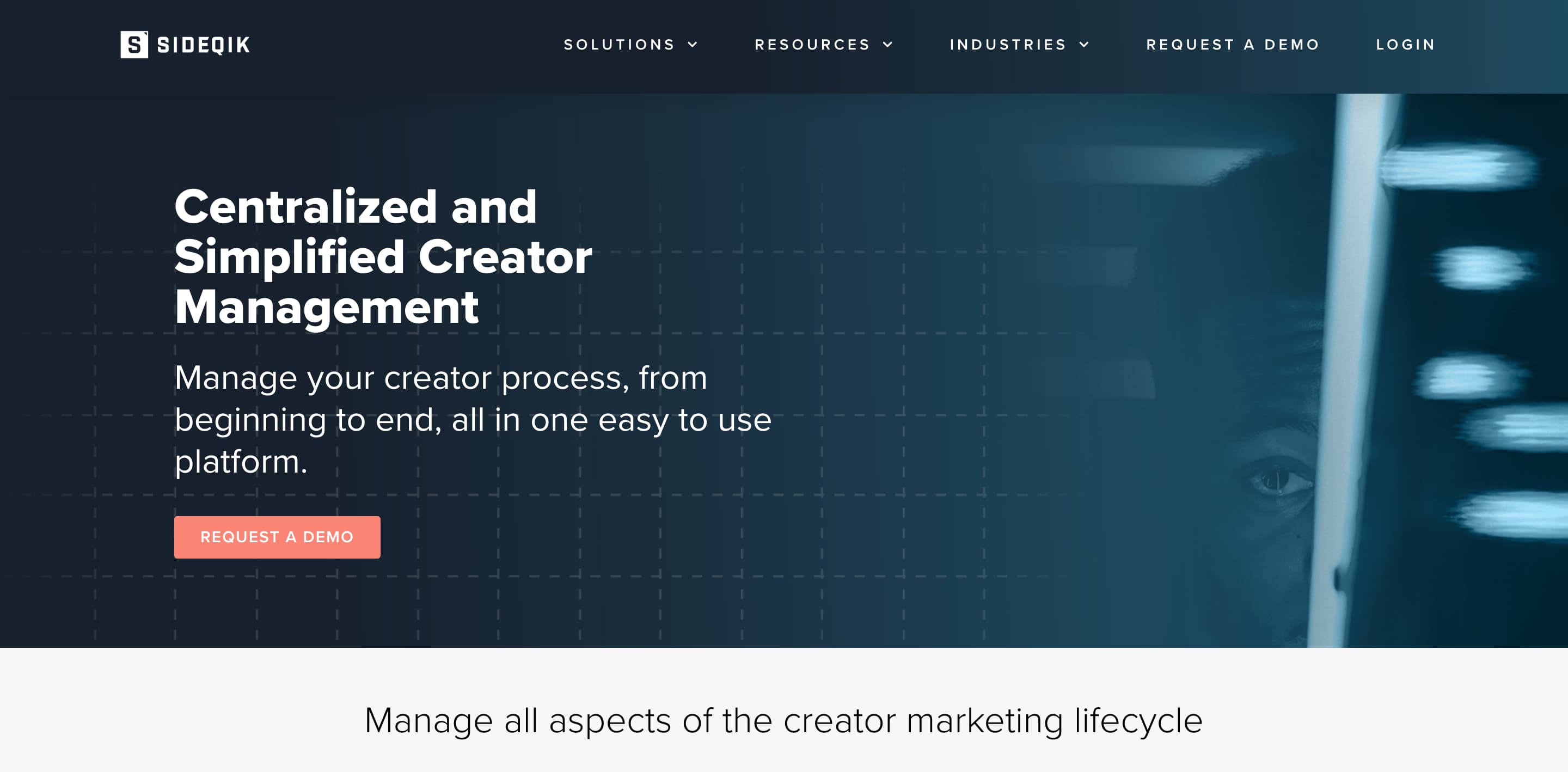
Best For: Sideqik is best suited for mid-market and enterprise brands that want an end-to-end solution for influencer marketing—covering discovery, campaign execution, and ROI tracking. Its deep Twitch and streaming integrations also make it a go-to platform for brands targeting gaming and live-stream audiences.
Platform Coverage:
Pricing: Undisclosed.
Reviews: 4.2 / 5.0 (G2)
Ease of Use (UX/UI): Users often highlight Sideqik as intuitive and time-saving when it comes to discovery, campaign tracking, and pulling influencer content. However, some reviewers note that the admin UI can feel cluttered and wish for better filters and flexible reporting time frames.
Customer Support: Sideqik generally receives praise for its responsive and collaborative account teams, with many users appreciating their openness to feedback. On the downside, a few users report frustrations around billing issues or miscommunication during onboarding, which can create a rocky start.
When comparing Cloutflow and Sideqik, the main difference lies in focus and pricing models. Cloutflow is designed around first-party authenticated data, giving brands confidence in influencer metrics and reducing fraud risks. It offers a free plan and scalable tiers starting from ~$199/month, making it accessible for smaller brands and startups. In contrast, Sideqik caters to larger enterprises, with broader coverage (20M+ creators across 10+ networks) and streaming-focused workflows. However, Sideqik’s pricing is undisclosed and tends to lean toward higher enterprise budgets.
For brands prioritizing data authenticity and transparent influencer payments, Cloutflow may be a better fit. But if you need comprehensive campaign workflows, Twitch integrations, and enterprise-grade analytics, Sideqik has the edge. Ultimately, budget-conscious brands may favor Cloutflow, while mid-market and enterprise players might lean toward Sideqik for its expanded features and integrations.
Exploring Cloutflow alternatives reveals that while Cloutflow offers transparency with first-party authenticated data and straightforward pricing, many competing platforms go further by offering stronger influencer discovery, automated outreach, advanced CRM systems, and robust reporting features.
Solutions like CreatorIQ, GRIN, Sideqik, and others cater to different needs, from enterprise-level integrations to niche campaign workflows. For brands weighing options, the decision often comes down to budget, ease of use, and the depth of features needed for scaling influencer marketing.
Among the platforms compared, Influencer Hero stands out as one of the best alternatives thanks to its intuitive dashboard, 24/7 live support with a dedicated account manager, and unique all-in-one suite that combines influencer search, outreach automation, UGC tracking, and detailed reporting.
With competitive pricing and features tailored for both growing brands and established enterprises, Influencer Hero provides the flexibility and support many marketers are looking for. If you’re ready to streamline your influencer marketing strategy, book a demo with Influencer Hero today and see how it can transform your campaigns.

Some of the best alternatives to Cloutflow include Influencer Hero, CreatorIQ, GRIN, Captiv8, and Upfluence. These platforms offer more advanced features such as AI-powered influencer discovery, campaign management, and performance analytics, which can help brands scale campaigns more efficiently.
While Cloutflow focuses on authenticated first-party data, Influencer Hero provides a more complete solution with influencer search, outreach automation, CRM, UGC tracking, and detailed reporting in one platform. It also includes 24/7 customer support and a dedicated account manager, making it one of the most reliable and user-friendly alternatives.
For small to mid-sized brands, Influencer Hero and GRIN are strong choices. Influencer Hero is especially appealing because of its intuitive dashboard, competitive pricing, and robust all-in-one functionality—ideal for brands that need efficiency without complex setup.
Cloutflow provides transparency and simplicity but can lack advanced integrations, analytics depth, and scalability. CreatorIQ, on the other hand, is designed for large enterprises with sophisticated needs, offering deep integrations, data-driven insights, and advanced reporting. However, this comes at a significantly higher cost compared to Cloutflow or Influencer Hero.
When evaluating alternatives, consider influencer discovery capabilities, campaign management tools, pricing, customer support, and analytics strength. If you want an affordable yet powerful all-in-one solution, Influencer Hero is one of the best picks, while platforms like Captiv8 and Sideqik may be better suited for brands seeking advanced analytics or niche campaign features.



Schedule a Demo with one of our media experts below.